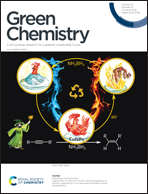Regenerated cellulose strongly adhered by a supramolecular adhesive onto the PVDF membrane for a highly efficient oil/water separation†
Abstract
The hydrophilic modification of polyvinylidene fluoride (HP-PVDF) membrane has gained increasing attention in recent years for the oil/water separation. Nevertheless, there are still challenges in the simple fabrication of inexpensive, eco-friendly and durable HP-PVDF membrane. In this study, a novel HP-PVDF membrane of cellulose-TA-PVA-PVDF with outstanding micro-nano-scale porosity, favorable durability, superhydrophilicity and underwater superoleophobicity was prepared by strongly adhering regenerated cellulose (RC) onto a PVDF membrane using supramolecular adhesive, tannic acid and polyvinyl alcohol (TA-PVA) complex. The preparation method possessed the merits of being simple, facile, non-toxic and cost-effective. The pore size of the RC layer on the surface of cellulose-TA-PVA-PVDF was conducive to demulsification, and the strong adhesive TA-PVA complex was helpful for improving the durability of the cellulose-TA-PVA-PVDF membrane. The developed cellulose-TA-PVA-PVDF membrane not only exhibited excellent oil/water separation efficiency (99.99%) and promising flux (318 L m−2 h−1 bar−1) but also achieved 99.7% separation efficiency after 30 cycles and 30 min of ultrasound. More importantly, the cellulose-TA-PVA-PVDF showed outstanding separation performance for real oil/seawater mixture. Hence, the cellulose-TA-PVA-PVDF membrane had considerable potential for practical applications in oil/water separation.


 Please wait while we load your content...
Please wait while we load your content...